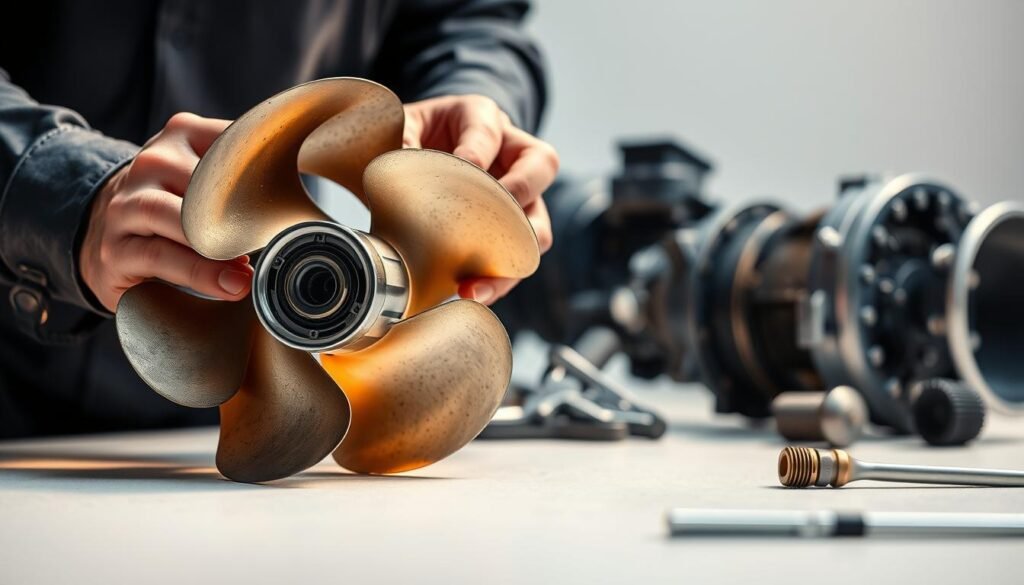The boat motor impeller is a critical component in marine engines, ensuring the cooling system operates efficiently. This small, rubber part plays a vital role in preventing engine overheating by drawing water from outside the vessel into the system.
Located within the water pump, the impeller’s flexible design allows it to move water through the engine. Without proper lubrication or timely replacement, this component can wear out, leading to potential engine damage.
For boat owners, understanding how the impeller works is essential. Regular maintenance ensures the engine stays cool, extending its lifespan and keeping your marine adventures safe and reliable.
Understanding What is a Boat Motor Impeller
Marine engines rely on the impeller to maintain optimal temperatures. This small but essential component ensures the cooling system functions smoothly, preventing overheating and potential damage.
Definition and Function
The impeller acts as the heart of the water pump. Its primary role is to draw water from outside the vessel and circulate it through the engine. This process keeps the engine cool, even during extended use.
Without proper lubrication, the impeller can wear out quickly. Running it dry increases the risk of damage, making regular maintenance a priority for boat owners.
Key Components and Materials
Constructed from durable rubber, the impeller features flexible blade-like fins. These fins compress and twist during installation, ensuring a secure fit on the shaft.
Other critical parts include the gasket, which seals the assembly, and the shaft connection. Together, these components ensure the impeller operates efficiently within the cooling system.
How the Impeller Operates Within the Cooling System
When the engine runs, the impeller spins, creating suction that pulls water into the pump. The water then flows through the engine, absorbing heat before being expelled.
This continuous cycle is vital for maintaining engine temperature. Regular inspections help identify wear or damage, ensuring the impeller remains in top condition.
| Component | Material | Function |
|---|---|---|
| Impeller | Rubber | Draws and circulates water |
| Shaft | Metal | Connects and rotates the impeller |
| Gasket | Rubber/Silicone | Seals the assembly |
Understanding the impeller’s role and operation helps boat owners maintain their engines effectively. Regular checks and timely replacements ensure the cooling system remains reliable year after year.
Impeller Maintenance and Replacement Guidelines
Keeping your engine cool relies heavily on proper impeller care. Regular maintenance and timely replacement ensure the cooling system operates efficiently, preventing overheating and costly repairs.
Proper Lubrication Techniques During Installation
Lubrication is critical when installing a new impeller. Using manufacturer-approved waterproof grease prevents dry starts and premature wear. Apply the lubricant evenly to the rubber fins and shaft for smooth operation.
Avoid oil-based products, as they can degrade the rubber over time. Proper lubrication ensures the impeller spins freely, reducing friction and extending its lifespan.

When and How to Replace Your Impeller
Replacing an impeller requires careful steps to avoid damaging the pump housing. Use an impeller puller to safely remove the old component. Inspect the shaft and gasket for wear or corrosion before installing the new part.
Compress and twist the new impeller into place, ensuring the fins align with the shaft. Engage the splines correctly to avoid misalignment. After installation, check for water seepage to confirm a proper seal.
Schedule replacements based on operating hours or annually, whichever comes first. Regular inspections during routine service intervals help identify early signs of wear, ensuring the cooling system remains reliable.
Troubleshooting Common Impeller Issues
Visual checks are essential to spot impeller problems before they escalate. Regular inspections help identify wear, cracks, or damage, ensuring the cooling system remains efficient. Addressing issues early prevents costly repairs and keeps your marine adventures smooth.
Visual Inspection: Identifying Signs of Wear and Damage
Start by examining the rubber fins for cracks or missing pieces. Worn blades reduce the pump’s ability to draw water, leading to engine overheating. Check the shaft for corrosion and ensure the gasket is properly seated to avoid leaks.
Look for discoloration or hardening of the rubber, which indicates aging. If the impeller shows signs of wear, replacing it promptly is crucial. Regular inspections during routine maintenance help catch these issues early.
Preventing Engine Overheating and Further Damage
A failing impeller disrupts the water flow, causing the engine to overheat. This can lead to severe damage if not addressed. Ensure the shaft is aligned correctly during installation to avoid misalignment issues.
Proper lubrication of the rubber fins prevents premature wear. Use marine-grade grease to keep the impeller functioning smoothly. Replacing the component annually or after extended use ensures the cooling system remains reliable.
By following these troubleshooting steps, boat owners can maintain their engine’s health and avoid unexpected breakdowns. Regular maintenance and timely replacements are key to a well-functioning water pump system.
Conclusion
Proper care of the cooling system ensures your marine engine runs smoothly. The impeller plays a vital role in maintaining optimal temperatures by circulating water through the pump. Regular maintenance and timely replacement prevent overheating and costly repairs.
Follow strict guidelines for lubrication and installation to extend the impeller’s lifespan. Inspect the shaft and gasket during replacements to ensure a secure fit. Addressing wear early avoids severe engine damage.
Schedule service annually or after a set number of operating hours. Explore online resources for additional tips and connect with trusted marine professionals. Proactive care keeps your engine reliable and your adventures safe.
